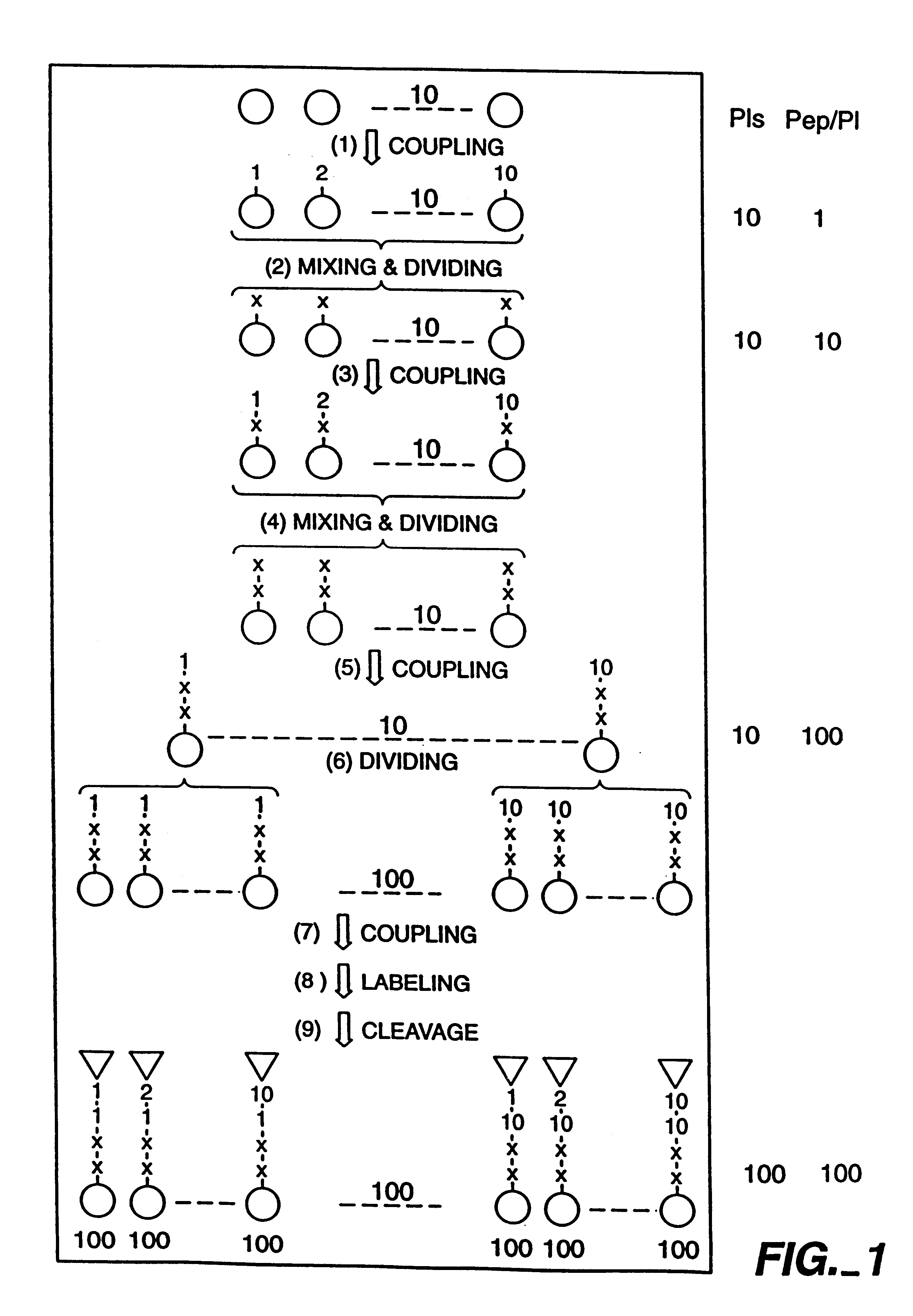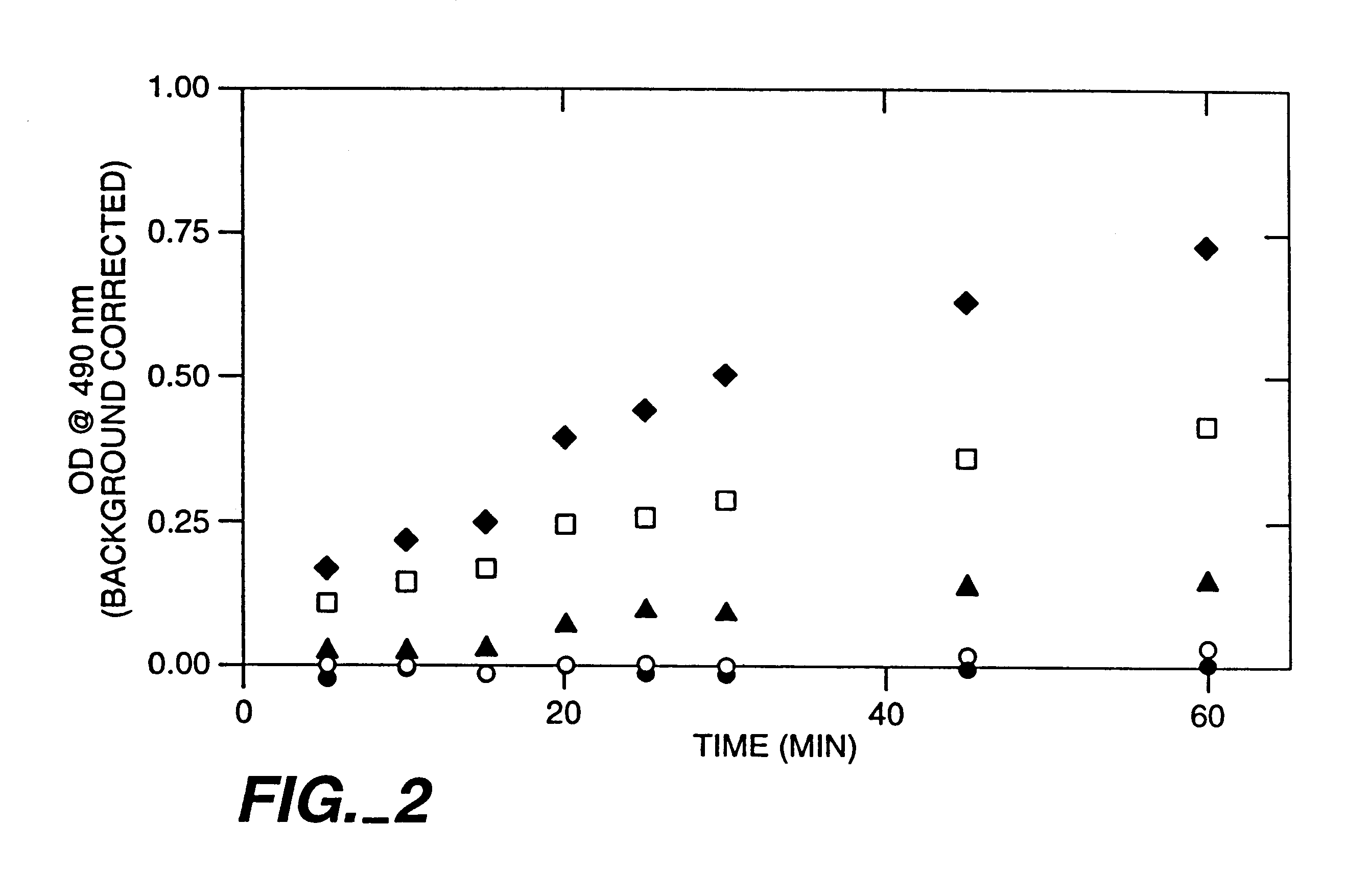Affinity labeling libraries and applications thereof
a technology of affinity labeling and library, applied in the field of affinity labeling libraries, can solve the problems of agonism or antagonism at the receptor site, affinity labeling of biological receptors and other non-catalytic proteins, and the inability to know the spatial location of potentially reactive groups on the receptor molecule and on the affinity label without specific structural information
- Summary
- Abstract
- Description
- Claims
- Application Information
AI Technical Summary
Problems solved by technology
Method used
Image
Examples
example 1
Construction of N-acetyl Glutamic Acid-Containing Affinity Labeling Libraries
Two N-acetyl glutamic acid-containing peptidyl affinity labeling libraries were designed and constructed for use in screening for specific affinity labeling of macromolecular targets. The structure of these two affinity labeling libraries is described as follows:
Affinity Labeling Library Number 1:
In each of the two above described structures, X.sub.1 and X.sub.2 represent any one of 10 selected amino acids in the L-configuration, O.sub.1 represents any one of 10 selected amino acids in the L-configuration and O.sub.2 represents any one of 10 selected amino acids in the D-configuration.
The L-amino acids X.sub.1, X.sub.2 and O.sub.1 were carefully selected to maximize diversity while minimizing any potential interference that may occur with the activated functional group of the affinity label molecule. The D-amino acids O.sub.2 were carefully selected in order to prevent facile peptidyl cleavage in vivo and t...
example 2
Construction of N-Biotinyl Glutamic Acid-Containing Affinity Labeling Library
One N-biotinyl glutamic acid-containing peptidyl affinity labeling library was designed and constructed for use in screening for specific affinity labeling of macromolecular targets. The structure of this affinity labeling library is described as follows:
As described in Example 1, in the above disclosed structure, X.sub.1 and X.sub.2 represent any one of 10 amino acids in the L-configuration, O.sub.1 represents any one of 10 selected amino acids in the L-configuration and O.sub.2 represents any one of 10 selected amino acids in the D-configuration. The 10 amino acids employed herein were the 10 amino acids set forth in Table I.
The N-biotinyl glutamic acid-containing affinity labeling library was constructed essentially as described above in Example 1 and as diagramed in FIG. 1. However, for coupling of the resin-bound tetrapeptides in each of the 100 independent and distinct pools to the L-glutamic acid der...
example 3
Construction of a Solid Phase Affinity Labeling Library
One solid phase peptidyl affinity labeling library w as designed and constructed for use in screening for specific affinity labeling of macromolecular targets. The structure of this solid phase affinity labeling library is similar to affinity labeling library number 2, but on a solid support and is prepared as follows
As described in Examples 1 and 2, in the above disclosed structure, X.sub.1 and X.sub.2 represent any one of 10 amino acids in the L-configuration, O.sub.1 represents any one of 10 selected amino acids in the L-configuration and O.sub.2 represents any one of 10 selected amino acids in the D-configuration. The 10 amino acids e mployed herein were the 10 amino acids set forth in Table I.
The synthesis of this library is similar to that for affinity labeling library number 3, except (1) a TFA stable PEG-resin was used and (2) coupling of .alpha.-carboxyl of N.sup..alpha. -acetyl-O.sup..gamma. -Fmoc-glutamic acid was spe...
PUM
| Property | Measurement | Unit |
|---|---|---|
| volume | aaaaa | aaaaa |
| pH | aaaaa | aaaaa |
| temperature | aaaaa | aaaaa |
Abstract
Description
Claims
Application Information
 Login to View More
Login to View More - R&D
- Intellectual Property
- Life Sciences
- Materials
- Tech Scout
- Unparalleled Data Quality
- Higher Quality Content
- 60% Fewer Hallucinations
Browse by: Latest US Patents, China's latest patents, Technical Efficacy Thesaurus, Application Domain, Technology Topic, Popular Technical Reports.
© 2025 PatSnap. All rights reserved.Legal|Privacy policy|Modern Slavery Act Transparency Statement|Sitemap|About US| Contact US: help@patsnap.com


